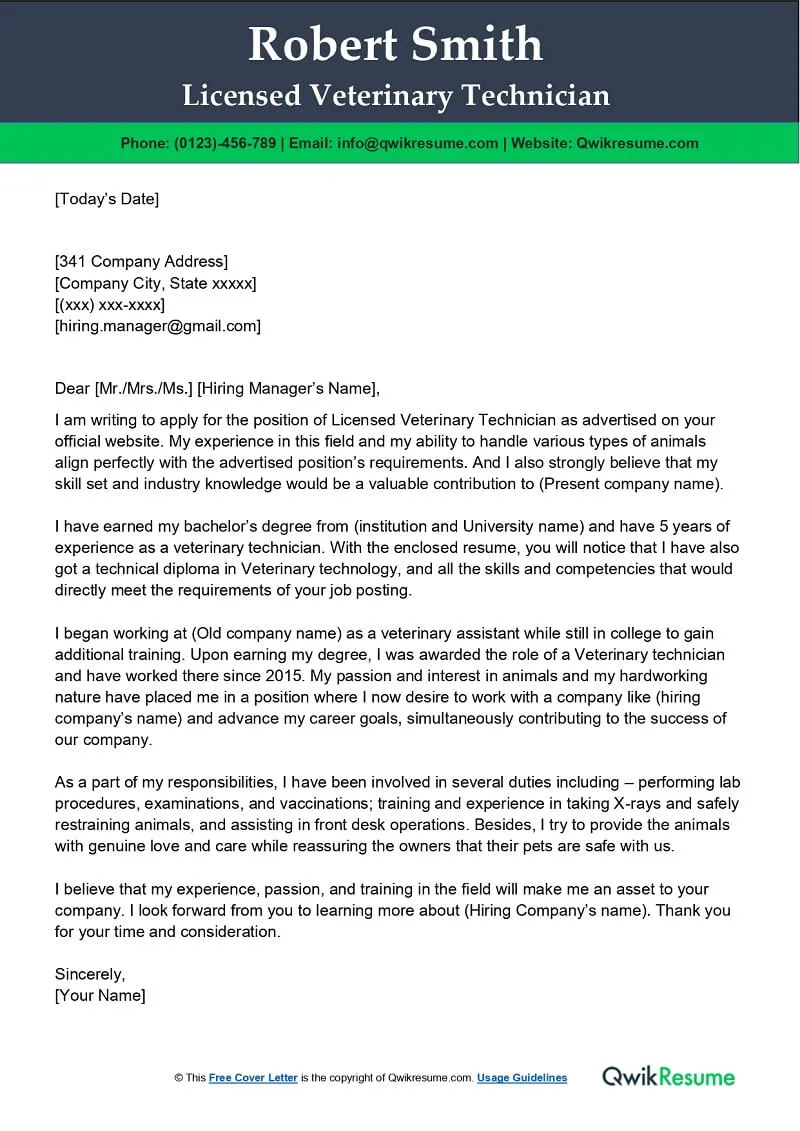Why a Veterinary Assistant Cover Letter is Crucial
A compelling veterinary assistant cover letter is your first chance to make a positive impression on a potential employer. It’s more than just a formality; it’s your opportunity to showcase your personality, passion for animal care, and suitability for the role. Unlike a resume, a cover letter allows you to provide context, explain your motivations, and demonstrate how your skills align with the specific needs of the veterinary clinic. A well-crafted cover letter can significantly increase your chances of landing an interview and ultimately, the job. It’s the key that unlocks the door to a career dedicated to animal welfare. Neglecting this crucial document can mean missing out on opportunities and being overlooked by hiring managers.
Highlighting Your Skills and Experience
Your cover letter should effectively highlight your skills and experience relevant to the veterinary assistant position. The goal is to demonstrate why you are the best candidate. This involves more than simply listing your qualifications. Instead, focus on providing specific examples of how you’ve applied your skills in the past and the positive outcomes you achieved. Think about the tasks typically performed by a veterinary assistant and tailor your examples accordingly. This section allows you to stand out from other applicants by illustrating your value proposition clearly. Emphasize your ability to handle various responsibilities, from assisting with medical procedures to providing compassionate animal care. Remember, this is where you sell yourself and demonstrate why you are the right fit.
Key Skills to Showcase
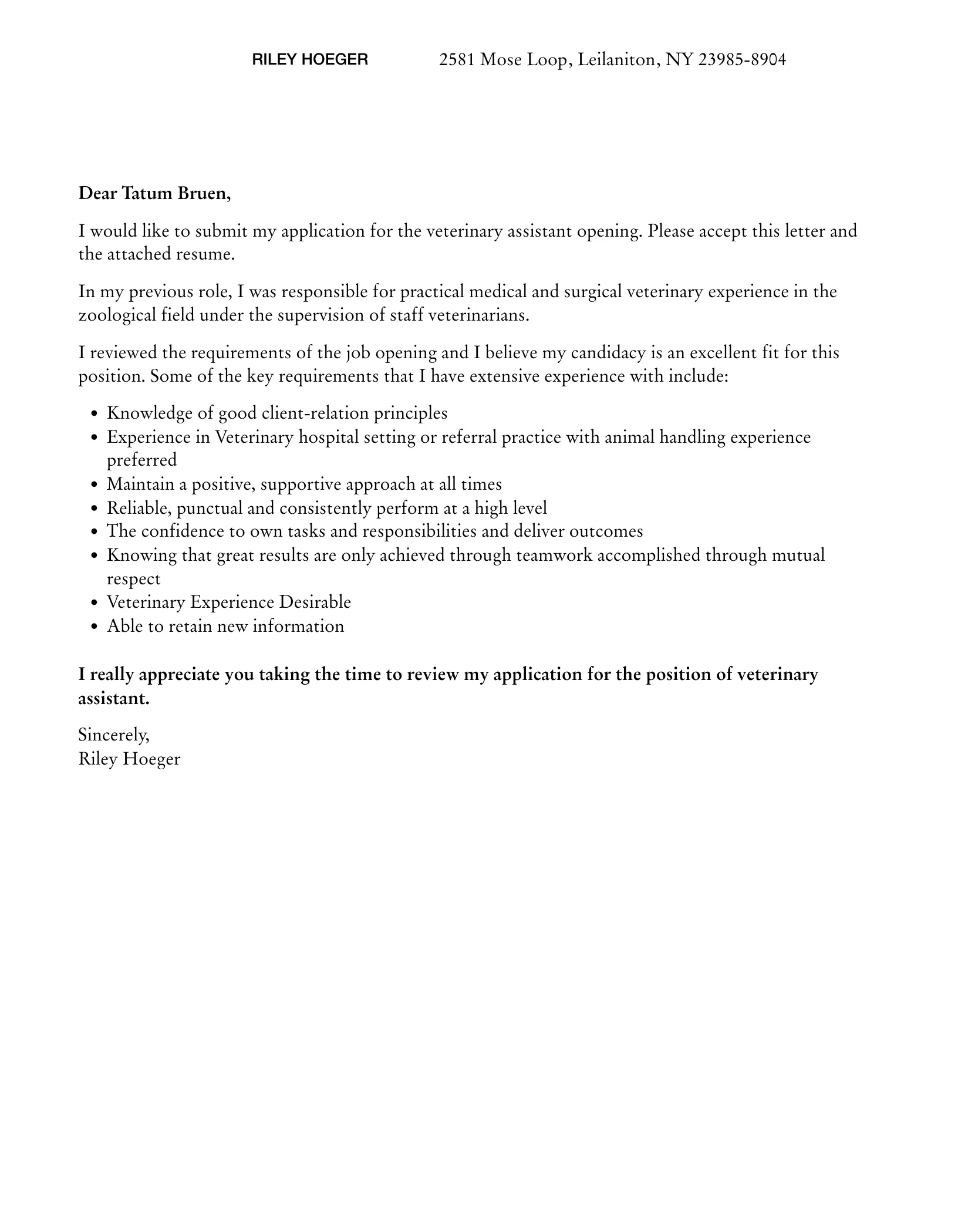
Certain skills are highly valued in veterinary assistant positions. In your cover letter, make sure to emphasize these, providing concrete examples of how you’ve utilized them. This includes skills like animal handling, where you showcase your ability to safely and effectively interact with various animals, understanding their behavior, and providing gentle care. Medical skills are also essential, such as administering medications, assisting with examinations, and taking vital signs. Effective communication skills are equally important, as you’ll need to interact with both pet owners and veterinary staff. Additionally, highlight your ability to work as part of a team, maintain a clean and organized work environment, and adapt to the fast-paced nature of a veterinary clinic. Including these key skills will make your cover letter stand out.
Relevant Experience Matters
Detailing your relevant experience is crucial for any veterinary assistant cover letter. Instead of just mentioning your past jobs, provide specific examples of your responsibilities and accomplishments. If you’ve volunteered at an animal shelter, specify the tasks you performed and the impact of your contributions. If you’ve worked in a veterinary clinic before, describe the medical procedures you’ve assisted with, the types of animals you’ve handled, and your role in providing care. Use action verbs to describe your duties and quantify your achievements whenever possible. For example, ‘Administered medications to over 20 animals daily’ or ‘Assisted in the successful completion of 15 surgeries’. The more specific your examples, the more convincing your letter will be. This part of your cover letter is where you can show practical experiences, therefore try to make it as descriptive as possible.
Formatting Your Cover Letter for Success
Proper formatting is essential to ensure your cover letter is professional, readable, and easily understood. Begin with a clear and professional header that includes your name, contact information, and the date. Use a standard business letter format with a formal salutation, such as ‘Dear Dr. [Last Name]’. Keep your letter concise and focused; aim for one page. Use a readable font, such as Arial or Times New Roman, and maintain consistent font sizes. Break up large blocks of text with paragraphs and headings to improve readability. Proper formatting not only makes your letter visually appealing but also demonstrates your attention to detail and professionalism. A well-formatted letter makes it easier for the hiring manager to quickly grasp your qualifications and assess your suitability for the role. Ensure your cover letter is easy to read, as this makes it more likely to be read thoroughly.
Contact Information and Professional Tone
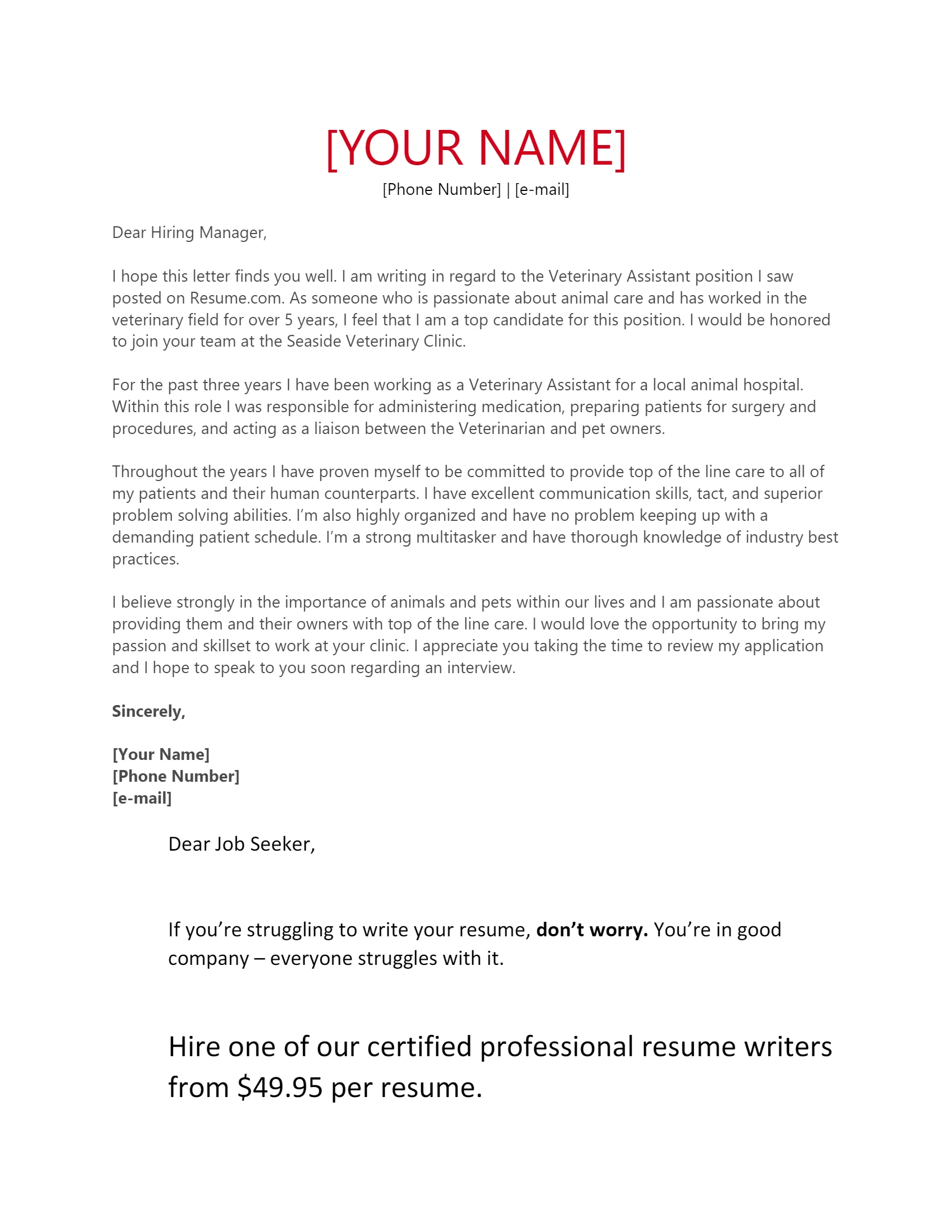
Your contact information should be accurate and easy to find. Include your full name, phone number, email address, and optionally, your LinkedIn profile URL. Use a professional email address; avoid using nicknames or unprofessional language. Maintain a professional tone throughout your cover letter. Use formal language and avoid slang or casual expressions. Proofread your letter carefully to ensure there are no grammatical errors or typos. Address the letter to the hiring manager or the specific contact person mentioned in the job posting. If you cannot find a specific name, use a general salutation like ‘Dear Hiring Manager’ or ‘Dear [Veterinary Clinic Name] Team’. Your overall presentation should be polished and reflect your commitment to professionalism, which is a core value in veterinary care. Showing you care about the details, suggests you are just as meticulous in your job.
Structuring Your Letter
Structure your cover letter logically to maximize its impact. Start with a strong opening paragraph that states the position you’re applying for and how you learned about the opportunity. In the body paragraphs, highlight your relevant skills and experience, providing specific examples to support your claims. Explain why you’re interested in this particular veterinary clinic, and what attracts you. This shows you have done your research. Close your letter with a call to action, expressing your interest in an interview and thanking the reader for their time and consideration. Keep your letter concise and to the point, highlighting only the most relevant information. This structure helps to ensure that your key qualifications are easily identifiable and that your application is well-organized, making it easy for the reader to quickly assess your potential as a candidate for the veterinary assistant position.
Tailoring Your Letter to the Clinic
A generic cover letter will likely get overlooked. Customize each cover letter you send to match the specific veterinary clinic and the job description. This shows that you are genuinely interested in the position and that you’ve taken the time to understand their needs. Research the clinic to learn about their services, values, and mission. Demonstrate how your skills and experience align with their specific requirements. Tailoring your letter also shows that you understand the clinic’s focus. For example, if they specialize in exotic animals, highlight any experience you have with these species. If they emphasize client communication, emphasize your interpersonal skills. Always adjust your language to match the clinic’s brand. This demonstrates your attention to detail and your proactive approach, significantly boosting your chances of getting an interview. Customizing your letter is a key differentiator.
Researching the Clinic and Understanding Their Needs
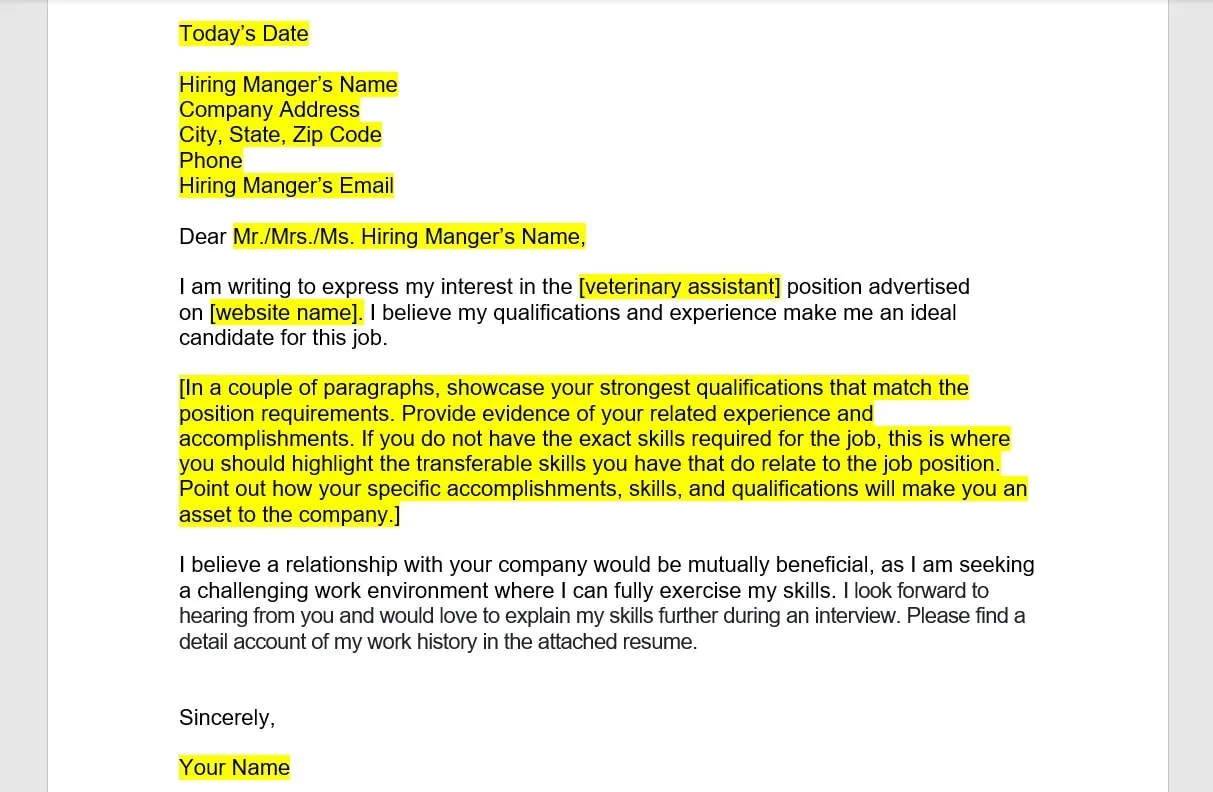
Before you begin writing your cover letter, conduct thorough research on the veterinary clinic. Visit their website, read their mission statement, and check out their social media profiles to learn about their values, services, and the types of animals they treat. This research will help you tailor your cover letter to their specific needs and demonstrate your genuine interest in the clinic. Look for information about their team, their approach to patient care, and any specializations they offer. Identifying their priorities allows you to highlight relevant skills and experiences that match their needs. For instance, if they emphasize client education, highlight your communication abilities and your experience in explaining medical procedures to pet owners. By understanding the clinic’s culture and priorities, you can create a compelling cover letter that resonates with the hiring manager and increases your chances of getting an interview.
Using Keywords from the Job Description
Carefully review the job description and identify the keywords used to describe the required skills and qualifications. Incorporate these keywords naturally throughout your cover letter. This can help your application get past Applicant Tracking Systems (ATS) and also show the hiring manager that you are a good fit. For example, if the job description mentions ‘animal handling,’ ‘medication administration,’ and ‘client communication,’ be sure to include these terms in your description of your past experience. Integrate these keywords into your sentences and paragraphs, highlighting your experience and accomplishments. However, avoid keyword stuffing; use the keywords naturally and strategically to enhance the readability of your letter. This strategic approach ensures that your cover letter accurately reflects the job requirements and demonstrates your suitability for the role, making it easier for your application to get noticed by the hiring team.
Proofreading and Polishing Your Cover Letter
Before submitting your cover letter, proofread it meticulously to catch any errors. Even a single typo or grammatical mistake can damage your professional image and undermine your application. Check for spelling errors, grammatical errors, and punctuation mistakes. Read your letter aloud to catch any awkward phrasing or sentence structures. Consider having a friend or family member review your cover letter, as a fresh pair of eyes can often spot errors that you may have missed. Ensure your formatting is consistent, and your contact information is accurate. A polished cover letter demonstrates your attention to detail and your commitment to excellence. Proofreading your cover letter is a small step, but it can make a significant difference in your chances of getting an interview. A well-written and error-free cover letter shows you care.
Common Mistakes to Avoid
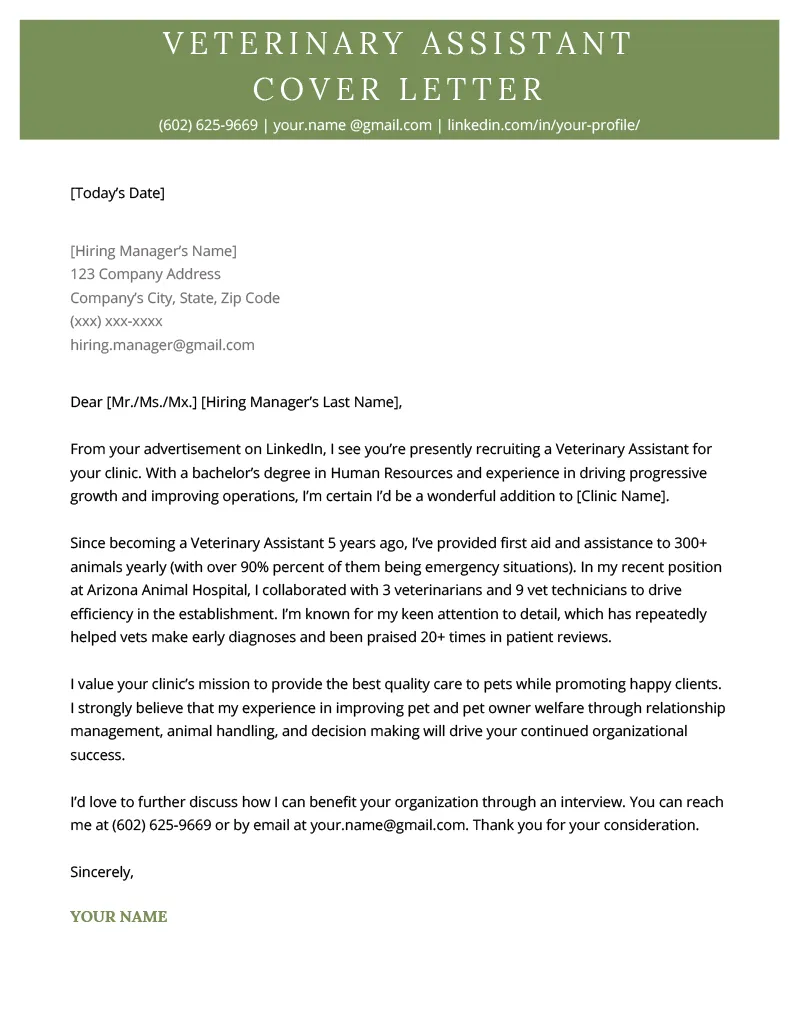
Avoid common mistakes that can hurt your chances of getting an interview. One major mistake is using a generic cover letter. Always tailor your letter to the specific clinic and job. Do not simply repeat your resume; use the cover letter to provide context and highlight your most relevant skills. Avoid writing long paragraphs that are difficult to read. Instead, keep your sentences and paragraphs concise. Never lie or exaggerate your qualifications, and always be honest about your experience. Do not use slang, informal language, or excessive jargon. Avoid negative language or complaints about previous employers. Finally, be sure to proofread your letter carefully to catch any spelling or grammatical errors. By avoiding these common mistakes, you can significantly improve the impact of your cover letter and increase your chances of success.
Finalizing and Submitting Your Application
Once you’ve crafted a compelling veterinary assistant cover letter, it’s time to finalize and submit your application. Save your cover letter as a PDF file to preserve the formatting and ensure that it can be opened on any device. Attach your cover letter and resume to your email or upload them through the online application portal, as specified in the job posting. Verify that all the contact information is correct, and double-check the email address to which you are sending your application. Review the application instructions carefully and follow them precisely. If the job posting includes specific instructions for submitting your application, be sure to adhere to them. After submitting your application, consider sending a follow-up email to express your interest in the position and confirm that your application was received. This additional step can demonstrate your enthusiasm and attention to detail.
